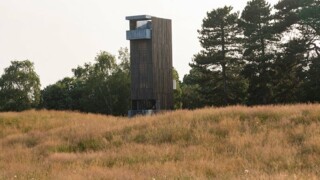Over Sutton Hoo
Gillian Darley
The archaeological site of Sutton Hoo in coastal east Suffolk has ‘seen an overwhelming increase in interest’ since the release of the movie The Dig. The National Trust, the site’s guardian, has seized the opportunity to build a new viewing tower, a gossamer structure of latticed galvanised metal and slatted dark-stained timber which stands at the furthest end of the site. The aerial perspective you gain from the platform 17 metres up, together with an elegant explanatory plan etched into metal, transforms the scene from a bumpy stretch of heath into the royal burial ground of an Anglo-Saxon monarch and his immense retinue, a place of unmistakable, if masked, resonance.
Sutton Hoo was given to the National Trust in 1998. Since then the organisation has tussled with the problem of what to do with a site of enormous significance but little visibility. The only burial mound conveying the scale of the originals is Mound 2, excavated in the 1960s and reconstructed. The owner of the land, Edith Pretty (Carey Mulligan in the movie), engaged a local archaeologist, Basil Brown (Ralph Fiennes, though you can see the man himself being interviewed by the BBC in 1965), who unearthed the key site, the Great Ship Burial in Mound 1, in the late 1930s. Almost all the artefacts from that excavation were taken to the British Museum. Most of the other eighteen burial places had been robbed over the centuries.
The National Trust began by commissioning a svelte museum, sited at a respectful distance from the burial ground, and more recently added a matching visitor centre. By these means they have animated the compelling shreds of stories about a figure of great importance – possibly King Rædwald of East Anglia – and his times. A monarch was ceremonially buried in the hull of his boat, surrounded by his court. The plunderers happily missed the greatest treasure and vegetation soon healed the wounds. Only the numerous hillocks suggested to the observant Mrs Pretty that she might have something out of the ordinary in the grounds of Tranmer House.
Now, from high up on the periscope-like lookout platform, visitors can better understand what occurred here. We can more easily picture another aspect of the story: the massive, heavy-laden funeral ship being hauled up from the estuary of the River Deben to the site above. Over centuries the visual connection has been lost, masked by mature woodland and marshland fringing the river, but the route of the funeral cortège for the king, as his 27-metre ship was dragged up the short steep bluff by an army of hands, lies below.
A multi-disciplinary team at Nissen Richards Studio designed the elegant yet functional tower and its simple graphics. It is integrated into, though quite distant from, the cluster of museum and visitor centre, which are centred around a metal sculpture of the ship, as well as Tranmer House. The overall plan is masterly, the detail sure. In form, the tower has something of the local fire-watching eyries in Rendlesham Forest, and also echoes the crop of eccentric water towers scattered over the flat, sandy landscape of the eastern coast, especially the House in the Clouds at Thorpeness, built in 1923, with the water tank at the top of the tower designed to look like a cottage, while people actually lived in the stalk beneath.
The filming of Sutton Hoo has inverted the usual process of popularisation: instead of a period location acting as the backdrop to a dramatised novel or fictionalised account of a historic figure, a new audience has been introduced to the site through its own back story.
